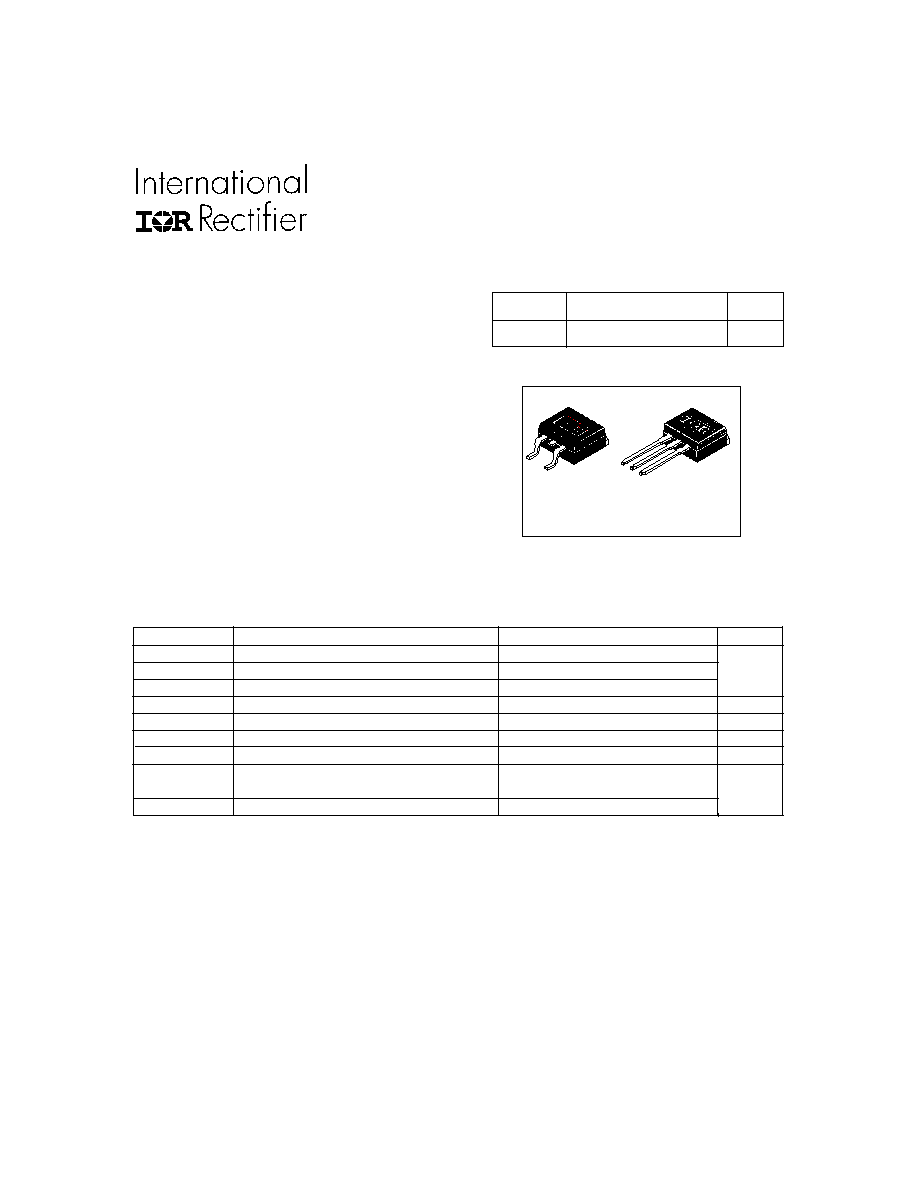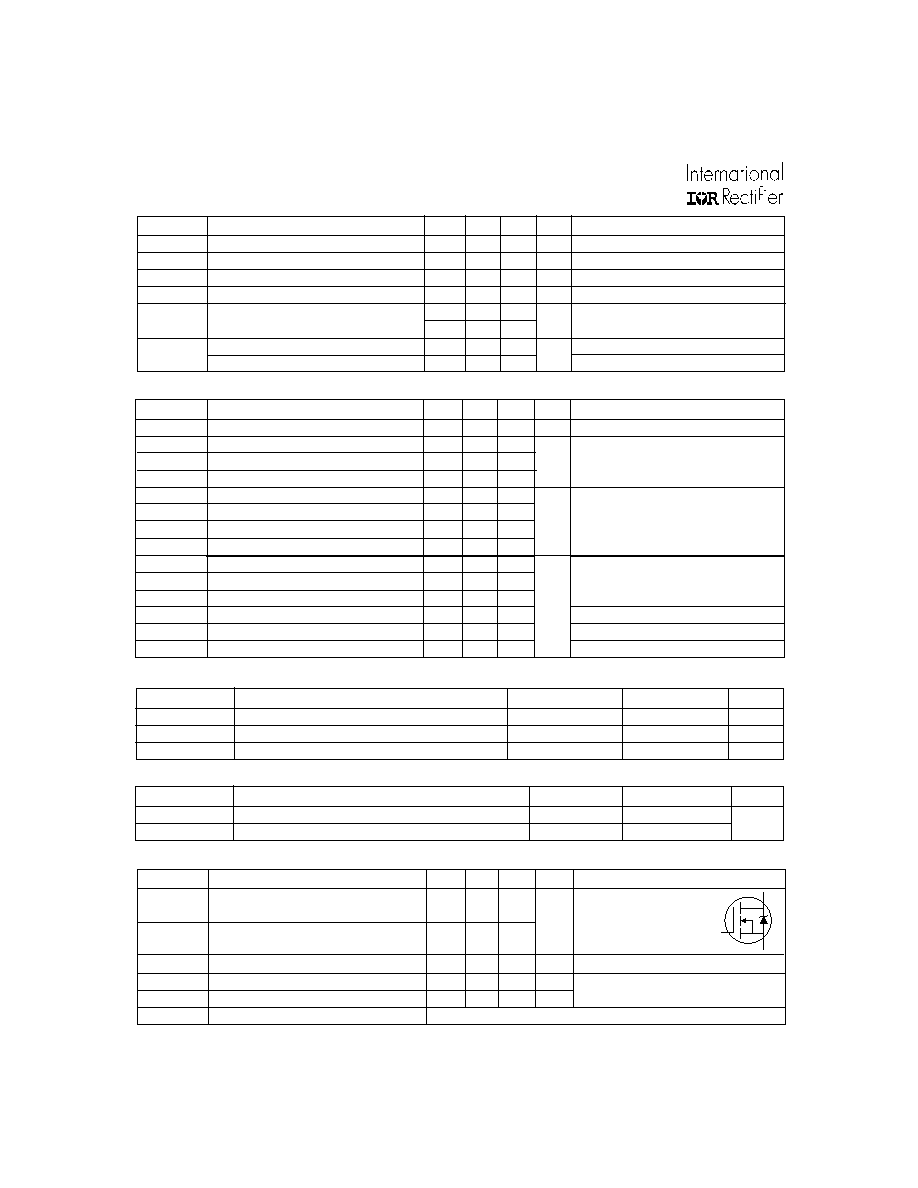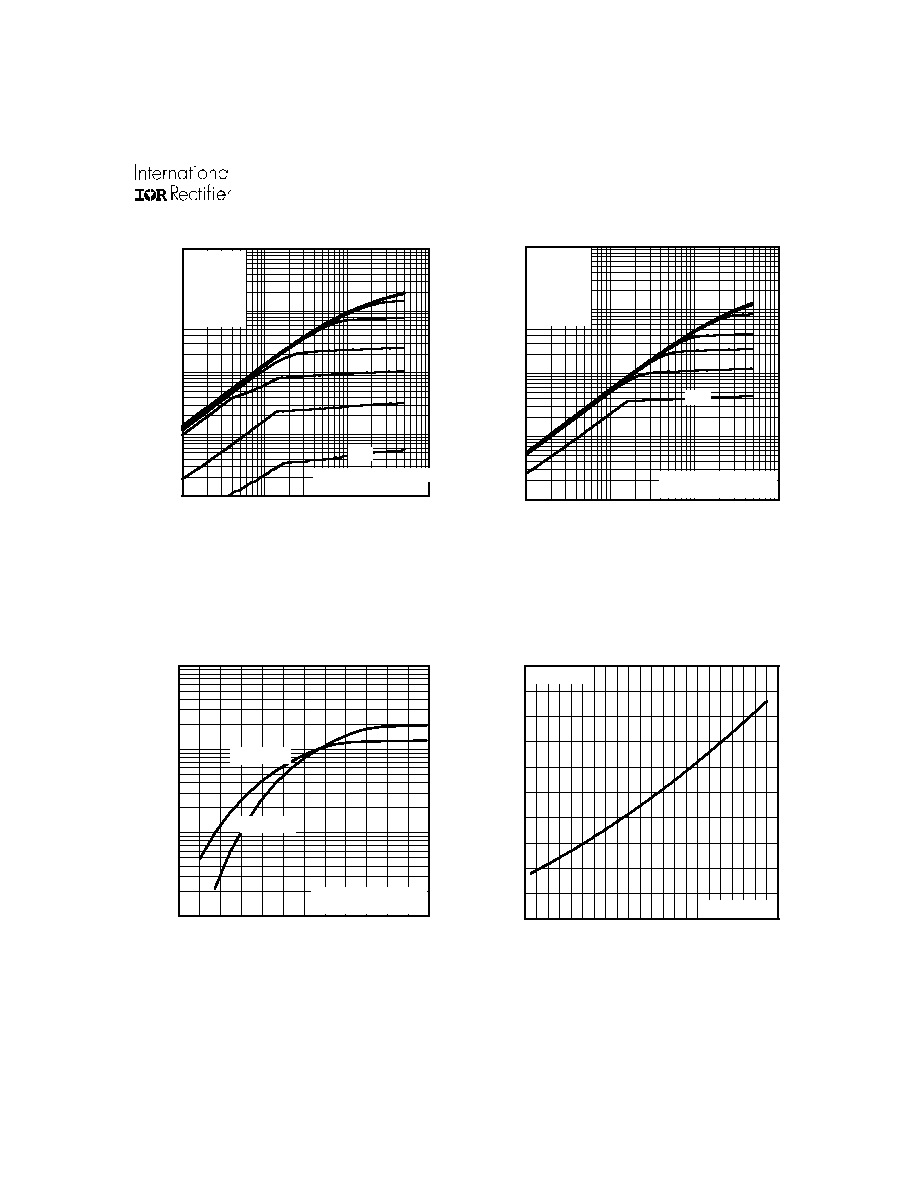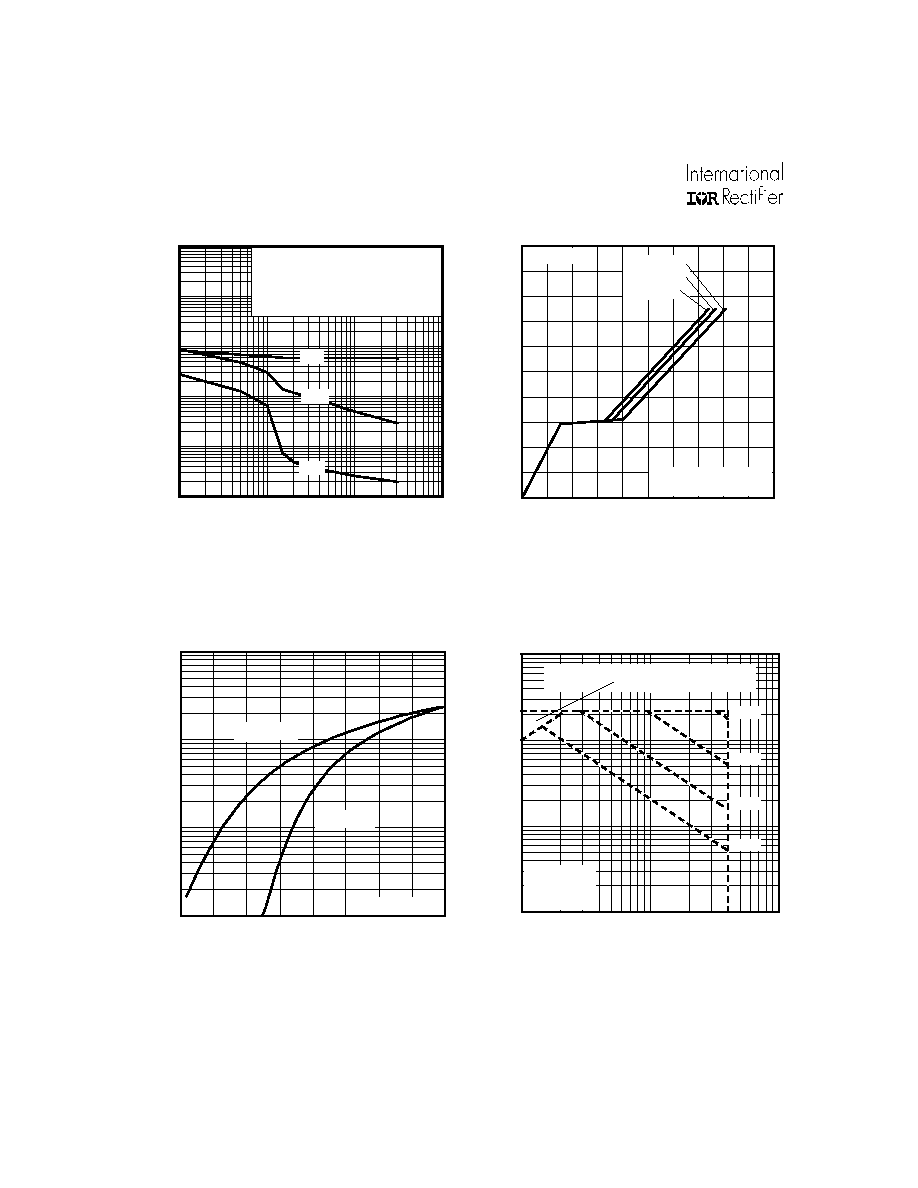 | ÐлекÑÑоннÑй компоненÑ: IRF730AS | СкаÑаÑÑ:  PDF PDF  ZIP ZIP |
Irf730as.p65

5/8/00
www.irf.com
1
IRF730AS/L
SMPS MOSFET
HEXFET
®
Power MOSFET
l
Switch Mode Power Supply (SMPS)
l
Uninterruptable Power Supply
l
High speed power switching
Benefits
Applications
l
Low Gate Charge Qg results in Simple
Drive Requirement
l
Improved Gate, Avalanche and dynamic
dv/dt Ruggedness
l
Fully Characterized Capacitance and
Avalanche Voltage and Current
V
DSS
Rds(on) max
I
D
400V
1.0
5.5A
Typical SMPS Topologies:
l
Single Transistor Flyback Xfmr. Reset
l
Single Transistor Forward Xfmr. Reset
(Both US Line input only).
Parameter
Max.
Units
I
D
@ T
C
= 25°C
Continuous Drain Current, V
GS
@ 10V
5.5
I
D
@ T
C
= 100°C
Continuous Drain Current, V
GS
@ 10V
3.5
A
I
DM
Pulsed Drain Current
22
P
D
@T
C
= 25°C
Power Dissipation
74
W
Linear Derating Factor
0.6
W/°C
V
GS
Gate-to-Source Voltage
± 30
V
dv/dt
Peak Diode Recovery dv/dt
4.6
V/ns
T
J
Operating Junction and
-55 to + 150
T
STG
Storage Temperature Range
Soldering Temperature, for 10 seconds
300 (1.6mm from case )
°C
Absolute Maximum Ratings
l
Effective Coss Specified (See AN1001)
PD-93772A
Notes
through
are on page 10
2
D Pak
T O -26 2

IRF730AS/L
2
www.irf.com
Parameter
Min. Typ. Max. Units
Conditions
g
fs
Forward Transconductance
3.1
S
V
DS
= 50V, I
D
= 3.3A
Q
g
Total Gate Charge
22 I
D
= 3.5A
Q
gs
Gate-to-Source Charge
5.8
nC
V
DS
= 320V
Q
gd
Gate-to-Drain ("Miller") Charge
9.3
V
GS
= 10V, See Fig. 6 and 13
t
d(on)
Turn-On Delay Time
10
V
DD
= 200V
t
r
Rise Time
22
I
D
= 3.5A
t
d(off)
Turn-Off Delay Time
20
R
G
= 12
t
f
Fall Time
16
R
D
= 57
,See Fig. 10
C
iss
Input Capacitance
600
V
GS
= 0V
C
oss
Output Capacitance
103
V
DS
= 25V
C
rss
Reverse Transfer Capacitance
4.0
pF
= 1.0MHz, See Fig. 5
C
oss
Output Capacitance
890
V
GS
= 0V, V
DS
= 1.0V, = 1.0MHz
C
oss
Output Capacitance
30
V
GS
= 0V, V
DS
= 320V, = 1.0MHz
C
oss
eff.
Effective Output Capacitance
45
V
GS
= 0V, V
DS
= 0V to 320V
Parameter
Min. Typ. Max. Units
Conditions
V
(BR)DSS
Drain-to-Source Breakdown Voltage
400
V
V
GS
= 0V, I
D
= 250µA
V
(BR)DSS
/
T
J
Breakdown Voltage Temp. Coefficient
0.5 V/°C Reference to 25°C, I
D
= 1mA
R
DS(on)
Static Drain-to-Source On-Resistance
1.0
V
GS
= 10V, I
D
= 3.3A
V
GS(th)
Gate Threshold Voltage
2.0
4.5
V
V
DS
= V
GS
, I
D
= 250µA
25
µA
V
DS
= 400V, V
GS
= 0V
250
V
DS
= 320V, V
GS
= 0V, T
J
= 125°C
Gate-to-Source Forward Leakage
100
V
GS
= 30V
Gate-to-Source Reverse Leakage
-100
nA
V
GS
= -30V
Static @ T
J
= 25°C (unless otherwise specified)
I
GSS
I
DSS
Drain-to-Source Leakage Current
Dynamic @ T
J
= 25°C (unless otherwise specified)
ns
Parameter
Typ.
Max.
Units
E
AS
Single Pulse Avalanche Energy
290
mJ
I
AR
Avalanche Current
5.5
A
E
AR
Repetitive Avalanche Energy
7.4
mJ
Avalanche Characteristics
S
D
G
Parameter
Min. Typ. Max. Units
Conditions
I
S
Continuous Source Current
MOSFET symbol
(Body Diode)
showing the
I
SM
Pulsed Source Current
integral reverse
(Body Diode)
p-n junction diode.
V
SD
Diode Forward Voltage
1.6
V
T
J
= 25°C, I
S
= 5.5A, V
GS
= 0V
t
rr
Reverse Recovery Time
370
550
ns
T
J
= 25°C, I
F
= 3.5A
Q
rr
Reverse RecoveryCharge
1.6
2.4
µC
di/dt = 100A/µs
t
on
Forward Turn-On Time
Intrinsic turn-on time is negligible (turn-on is dominated by L
S
+L
D
)
Diode Characteristics
5.5
22
A
Thermal Resistance
Parameter
Typ.
Max.
Units
R
JC
Junction-to-Case
1.7
°C/W
R
JA
Junction-to-Ambient ( PCB Mounted, steady-state)*
40

IRF730AS/L
www.irf.com
3
Fig 4. Normalized On-Resistance
Vs. Temperature
Fig 2. Typical Output Characteristics
Fig 1. Typical Output Characteristics
Fig 3. Typical Transfer Characteristics
0.01
0.1
1
10
100
0.1
1
10
100
20µs PULSE WIDTH
T = 150 C
J
°
TOP
BOTTOM
VGS
15V
10V
8.0V
7.0V
6.0V
5.5V
5.0V
4.5V
V , Drain-to-Source Voltage (V)
I , Drain-to-Source Current (A)
DS
D
4.5V
0.1
1
10
100
4.0
5.0
6.0
7.0
8.0
9.0
10.0
V = 50V
20µs PULSE WIDTH
DS
V , Gate-to-Source Voltage (V)
I , Drain-to-Source Current (A)
GS
D
T = 25 C
J
°
T = 150 C
J
°
-60 -40 -20
0
20
40
60
80 100 120 140 160
0.0
0.5
1.0
1.5
2.0
2.5
T , Junction Temperature ( C)
R , Drain-to-Source On Resistance
(Normalized)
J
DS(on)
°
V
=
I =
GS
D
10V
5.9A
0.01
0.1
1
10
100
0.1
1
10
100
20µs PULSE WIDTH
T = 25 C
J
°
TOP
BOTTOM
VGS
15V
10V
8.0V
7.0V
6.0V
5.5V
5.0V
4.5V
V , Drain-to-Source Voltage (V)
I , Drain-to-Source Current (A)
DS
D
4.5V
5.5

IRF730AS/L
4
www.irf.com
Fig 8. Maximum Safe Operating Area
Fig 6. Typical Gate Charge Vs.
Gate-to-Source Voltage
Fig 5. Typical Capacitance Vs.
Drain-to-Source Voltage
Fig 7. Typical Source-Drain Diode
Forward Voltage
0.1
1
10
100
10
100
1000
OPERATION IN THIS AREA LIMITED
BY R
DS(on)
Single Pulse
T
T
= 150 C
= 25 C
°
°
J
C
V , Drain-to-Source Voltage (V)
I , Drain Current (A)
I , Drain Current (A)
DS
D
10us
100us
1ms
10ms
0
5
10
15
20
25
0
4
8
12
16
20
Q , Total Gate Charge (nC)
V , Gate-to-Source Voltage (V)
G
GS
FOR TEST CIRCUIT
SEE FIGURE
I =
D
13
5.9A
V
= 80V
DS
V
= 200V
DS
V
= 320V
DS
0.1
1
10
100
0.4
0.6
0.8
1.0
1.2
V ,Source-to-Drain Voltage (V)
I , Reverse Drain Current (A)
SD
SD
V = 0 V
GS
T = 25 C
J
°
T = 150 C
J
°
5.5
1
10
100
1000
VDS, Drain-to-Source Voltage (V)
1
10
100
1000
10000
100000
C, Capacitance(pF)
Coss
Crss
Ciss
VGS = 0V, f = 1 MHZ
Ciss = Cgs + Cgd, Cds SHORTED
Crss = Cgd
Coss = Cds + Cgd

IRF730AS/L
www.irf.com
5
Fig 10a. Switching Time Test Circuit
Fig 10b. Switching Time Waveforms
Fig 11. Maximum Effective Transient Thermal Impedance, Junction-to-Case
Fig 9. Maximum Drain Current Vs.
Case Temperature
V
DS
Pulse Width
1
µs
Duty Factor
0.1 %
R
D
V
GS
R
G
D.U.T.
10V
+
-
V
DD
V
DS
90%
10%
V
GS
t
d(on)
t
r
t
d(off)
t
f
25
50
75
100
125
150
0.0
1.0
2.0
3.0
4.0
5.0
6.0
T , Case Temperature
( C)
I , Drain Current (A)
°
C
D
0.01
0.1
1
10
0.00001
0.0001
0.001
0.01
0.1
1
Notes:
1. Duty factor D = t / t
2. Peak T = P
x Z
+ T
1
2
J
DM
thJC
C
P
t
t
DM
1
2
t , Rectangular Pulse Duration (sec)
Thermal Response
(Z )
1
thJC
0.01
0.02
0.05
0.10
0.20
D = 0.50
SINGLE PULSE
(THERMAL RESPONSE)




